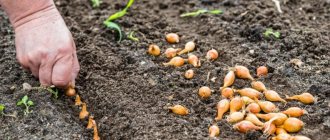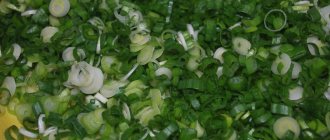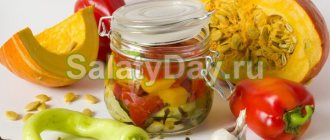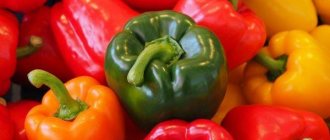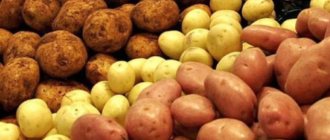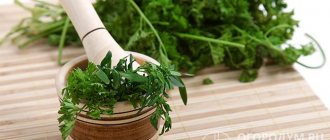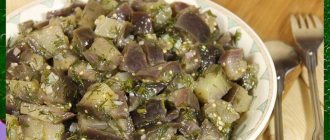Parsley and dill for the winter - a classic and quick recipe
This method is suitable not only for parsley or dill, it can also be used to preserve other herbs, for example, sorrel, cilantro, nettle, green onions, etc. But most often housewives roll up these two types of greens, because they are indispensable in preparing almost any winter or autumn dish.
To prepare several jars of such “green” canned food, you will need a minimum set of ingredients in the form of 2 bunches of each type of greens and table salt.
The dill is thoroughly washed, the yellowed parts are removed and dried at room temperature. Then cut into small pieces along with the roots. The same manipulations are carried out with parsley, which must be dried and as fresh as possible.
Next, mix the chopped parts, place them in a deep enamel pan or bowl and sprinkle with at least 1/2 standard glass of table salt on top.
Mix the ingredients again, transfer them into clean glass jars and compact them well, then close the lids and put them in the refrigerator for storage.
How long can it be kept without freezing?
Most often used:
- parsley,
- dill,
- onion feathers,
- celery,
- cilantro,
- broadleaf sorrel, spinach.
The following became popular:
- tarragon,
- basil,
- arugula,
- wild garlic,
- mint.
Storage time without freezing depends on the type of greens.
The optimal period is considered to be 2 weeks. The temperature should be around 0 °C.
Spinach will last up to 3 months without freezing , sorrel - up to a month.
Parsley and dill are stored on the top shelf of the refrigerator for a month. Glass jars or cellophane bags are used as containers.
In the summer, they are stored for a week, hiding the clean, juicy branches in a saucepan and covering them with a lid from the sun's rays. When dried, it retains its aroma and beneficial properties for a year.
Hard celery leaves can be stored for one and a half months . Lettuce cut with the stalk will last 5 weeks. Onions with feathers can be stored for 20 days if you hide the roots after moistening them with water.
Cilantro for the winter in sunflower oil - a simple way to prepare
Cilantro is known to many for its unique aroma. At the same time, it has a large number of useful properties. It is used to prepare adjika, spicy sauces, seasoning hot dishes, etc. This recipe will help you easily preserve the vitamin and taste qualities of the herb for the winter.
The basic rule for obtaining tasty preserves is to carefully select fresh cilantro so that no yellow, rotten or dried parts get into the jar, and rinse it in water, then let it stand and dry on the windowsill. Next, it is finely chopped, as for a regular salad.
They compact everything into jars, pour fresh sunflower or olive oil on top, and then close with a screw cap and store in the refrigerator.
Salt, spices or vinegar are not used in this case, although if you plan to store this herb for a long time, then add a little essence and a few pinches of table salt along with the oil.
How to Keep Cilantro Fresh in the Refrigerator
Fresh cilantro should be stored in a cool place. It can “last” on the refrigerator shelf for up to 3 weeks.
The question of how to keep cilantro fresh in the refrigerator interests many lovers of this aromatic greenery.
The purchased (collected) bunch of herbs is sorted out, removing spoiled leaves and weeds. After this, trim the stems a little and place them in a jar of water (do not wash it first). Only the lower part of the stems should be in the liquid, but not the leaves. Cover the top of the green “bouquet” with a plastic bag and put it in the refrigerator, on the middle shelf.
The leaves will retain their juiciness and bright green color for the same amount of time when kept in tightly closed bags or food containers. So that the condensation inside has somewhere to go, a napkin is placed in the bag with cilantro, which will then need to be replaced with a dry one.
Canned sorrel with sterilization is an excellent preparation for green soup
This greenery has a large amount of useful substances, and sorrel soup, when prepared correctly, turns out to be very tasty and rich. Sorrel is often used in recipes for second courses, especially in the southern regions of the country, where this herb is so popular.
For preservation you will need fresh herbs, table salt and clean water, adding a small amount of vinegar is allowed. First, wash the greens and let them dry.
At this time, prepare the dishes for seaming, sterilizing them in boiling water in the “old-fashioned” way or leaving them in the oven for 20-30 minutes under steam. You can use the special function in a microwave oven.
As soon as the grass has dried from the water, it is cut into small slices as for a salad, then tamped with a spoon into already prepared, clean jars, sprinkled with 1-2 tablespoons of salt on top, depending on the amount of greens chosen and the container capacity.
Afterwards, shake the jars a little so that the salt passes over the entire area and pour boiling water from a saucepan or kettle, immediately closing the lids.
As soon as the seams have cooled (cover them with a towel or warm cloth and turn them over), you can put them in the refrigerator and use fresh sorrel at any time of the year at your discretion.
Features of storing lemon products
You can make a variety of preparations from lemons. This allows you to significantly increase the shelf life of fruits.
Jam
To make lemon jam, do the following:
- Prepare 1 kilogram of peeled fruits. It is also worth taking 1.5 kilograms of sugar and 500 milliliters of water.
- Place all ingredients in an enamel container and place over low heat.
- Cook the syrup in several stages. At the first stage, the mixture needs to be boiled for 7 minutes, then left to infuse for 10 hours. Then boil for 10 minutes and leave for 12 hours. At the final stage, boil the lemons for 15 minutes and pour into jars.
- Turn the dish upside down and leave to cool.
- The workpiece should be kept in a dark and cool place.
Candied fruit
To make candied fruits, it is recommended to soak lemon zest in water for 3 days. Then the crusts must be doused with boiling water and cooked in sugar syrup. Finally, the candied fruits are dried in the oven.
Lemon with honey
The composition based on these products helps to cope with colds and viral diseases. This mixture has excellent taste.
To prepare a healthy product, you should do the following:
- Wash and peel the fruits.
- Grind the fruit with a blender.
- Mix lemons with honey in a 2:1 ratio.
- Place in a glass container and leave for half an hour. This is done at room temperature.
- Then put it in a dark place. It is recommended to keep the product at a temperature of +10 degrees and a humidity of 70%.
Zest
This product is very popular. It is actively used in desserts and baked goods. Crushed citrus peels add a pleasant aroma to dishes and help avoid the addition of synthetic ingredients.
To preserve the zest, you should follow these steps:
- Use a vegetable peeler to remove the yellow layer of peel;
- Place thin slices on parchment;
- cover with gauze;
- place the product on the windowsill and make sure that it is not exposed to direct sunlight;
- After 2 days, transfer to a jar and keep at room temperature.
With ginger
This effective remedy helps fight viruses and strengthens the immune system. To prepare it you should do the following:
- wash and peel the fruits;
- cut citrus fruits and grind using a meat grinder;
- remove the top layer from the ginger;
- grind the root using a grater;
- mix the ingredients and add liquid honey;
- put the mixture into jars and close tightly;
- refrigerate and store for a maximum of 1 month.
Lemon juice
To make juice, you should do the following:
- pour pieces of fruit and sugar into the juicer - for 1 kilogram of fruit take 400 grams of granulated sugar;
- when the juice is ready, it should be poured into jars and rolled up;
- turn upside down and cool.
Freezing dill for the winter in the traditional way
To preserve the beneficial and tasteful qualities of such fragrant and popular greens as dill, it can be rolled into jars with salt, dried or frozen for the winter in the refrigerator. It is the latter method that is most preferable, since the grass in this case retains a maximum of vitamins and remains fresh and aromatic.
The same method can be used to dry parsley leaves, cilantro and other herbs. The most important thing is to select them correctly, rinse them thoroughly in clean water, and remove all damaged or unusable areas.
Then the dill is allowed to dry a little and the umbrellas along with the sticks are cut with a sharp knife or frozen whole. They are placed in ordinary plastic bags or in special containers without holes and completely sealed.
After laying the herbs, be sure to release as much air as possible from the bag, and then tie it tightly in a knot and put it in the freezer. If possible, turn on the quick freezing function and leave the greens for 2-3 hours, and only then switch to the optimal temperature.
Drying
Dried green onions are included in many seasonings and freeze-dried soups. Its taste and smell become especially soft when dried.
There are 3 ways to prepare dried spices for the winter:
- In an electric dryer. Wash and cut the onion feathers into 2–3 cm strips. Place in the dryer in a thin layer. Set the temperature to 40–50 degrees and dry for 2–5 hours.
- In the oven. Wash and chop the greens. Dry. Turn the oven on to the lowest temperature (up to 100 degrees). Line the grill with paper. Pour in the chopped onions and spread in a thin layer. Dry with the door open for 1 hour, stirring the greens occasionally. Let it rest for 2 hours and repeat the procedure.
- On air. Chopped greens can be dried in the open air. Place it on paper in the shade. Cover with gauze to protect from debris, bugs and flies. After 2-3 days, the sun and air will do their job.
Pickled green onions in jars
Fresh and juicy green onions can be pickled like other greens, but it is best to combine them with fragrant dill. First of all, it is selected and washed with cold water. As soon as the onion is dry, cut into small rings and also chop the dill as finely as possible.
The greens are mixed and placed in clean glass jars, and sprinkled with a certain amount of salt on top, at least a quarter cup per 1 liter container.
Now the jars are closed with screw caps; shaking the dishes is not necessary; let the salt remain as the top layer.
Another way to pickle green onions is to roll them whole in brine. The dressing will remove excess bitterness from the green vegetable, it will become softer, juicier and sweet and sour in taste.
To prepare the marinade, use salt, sugar, vinegar and a little fresh or dried dill. The onion is washed with water, small parts are selected that will fit in jars under the neck.
Add bay leaf, allspice, other spices as desired, salt and sugar to taste to the water on the stove. Allow the brine to boil for 10 minutes, add a spoonful of vinegar to it and pour in the hot onions laid out in the jars.
You can store the workpiece in the refrigerator or on dark shelves at a comfortable temperature. There is no need to turn over and wrap warm jars after rolling the lids. Let them cool naturally, this way the onions will better retain their crunchy properties.
Adjika with herbs and chili peppers for the winter - a sauce for real gourmets
Adjika, made from fresh parsley, celery, dill and hot pepper, is a storehouse of vitamins and an ideal remedy for maintaining immunity during the winter. In addition, the sauce is very piquant, refreshing and suitable for serving with hot meat or fish dishes.
To prepare this unusual and spicy sauce, you need the following ingredients:
- fresh parsley and celery - 500 g each;
- chili pepper - 2-3 pods;
- dill and horseradish leaves - 1 bunch each;
- salt, vinegar and other spices to taste.
All greens are thoroughly washed and dried. For cooking, it is better to take fresh, juicy herbs from the first harvest, then the taste of the sauce will be more intense. The garlic is peeled and divided into slices, the pepper is carefully cut into quarters and the seeds are removed.
Next, the washed and chopped vegetables are passed through a meat grinder or in a kitchen blender so that a homogeneous mass of “green” puree is formed. Add salt and spices to taste, you can add 1-2 tablespoons of sugar to take the edge off a little. Mix everything well and pour in a small amount of vinegar.
After the mixture has infused a little, it is sorted into clean and sterile jars, the container is tightly rolled up and sent for standard storage in a refrigerator, cool cellar or basement.
Dried roots and leaves of parsley at home - preparatory stage
Parsley can be called the most popular spice for preparing a wide variety of dishes. To preserve all the properties of this greenery, it is prepared for the winter in the form of canning with other herbs, or the branches and roots are dried in one of the following ways and used as a high-quality seasoning.
Fresh, fully ripened leaves without yellow spots, limp or rotten parts are usually selected for drying. If such areas are found, they are trimmed and removed.
Next, the grass is first rinsed in a container with clean water, and then passed under the tap again. Place the greens on paper or cloth towels and let them dry.
The roots of the plant are washed with a brush, and then the top layer of peel is peeled off with a sharp knife and cut into small slices or rings. As soon as the grass has dried, begin the drying process using one of the convenient methods. The simplest of them is to dry the greens naturally on a windowsill or outside in favorable summer weather.
The right time to harvest
Many people are familiar with the truth that if you don’t have time, it means you’re late.
This is especially true for harvesting. Before you have time to pick the strawberries, they will rot. If you miss time with apples, there will be nothing to collect. What about spices? When is the best time to collect herbs for the winter to get a quality product? Let's consider the advice of experts. According to experts, spicy plants are collected before flowering. At this time, the foliage is very soft and contains a huge amount of substances beneficial to health. After all, when flowering, herbs direct their forces to the development of buds. And after it, they lose their aroma and acquire a bitter taste.
Before you prepare herbs for the winter, you need to note the following points:
- flowering period;
- weather;
- Times of Day;
- type of plant (annual, perennial);
- procurement method.
Since all herbs are different, it means that each has its own flowering period. Simple observation will help determine when and how to prepare herbs for the winter. Let's look at some of them:
- Parsley. This perennial plant is ready to harvest when mature foliage emerges.
- Cilantro. The aromatic spice is harvested as soon as the bushes reach 12 cm in height.
- Basil (oregano). In mid-summer the plant is most suitable for harvesting.
- Rosemary. In southern latitudes it is harvested several times throughout the year.
- Mint. It blooms at the end of May, so it is important not to miss the moment.
- Melissa. It is best to pick in mid-June before the buds appear.
Similar guidelines are also used when herbs are collected for drying. It is good to do this early in the morning after the moisture has evaporated. Some people cut greens in the evening, when dew has not yet appeared on the grass. As a result, there will be virtually no dirt or dust on them. This method is used for harvesting marjoram, sage, thyme and dill. To preserve the beneficial properties and aroma of spices, they are dried naturally.
Drying herbs using traditional methods
To do this, it is crushed or left whole in the form of fluffy bunches. Then place it on a flat surface, tray or board in a layer of no more than 1 centimeter, but so that the parts of the parsley do not overlap each other. And store in a well-ventilated area at room temperature.
To prevent chlorophyll and other beneficial elements from being lost from the composition of the herbs, and to prevent the herbs from turning yellow, it is necessary to avoid exposure to direct sunlight. Therefore, the storage place should be shaded. The period of such drying ranges from 10 to 14 days, depending on conditions. At the same time, periodically mix the chopped greens with your hands.
If you decide to dry parsley in bunches, then they are usually either tied on ropes with the foliage down, or also carefully laid out on a tray or other suitable surface and sent to dry, as if they were chopped. The process is similar when drying roots.
A faster way to prepare greens for the winter is dried in the oven. To do this, it is heated to a temperature of 50-70 degrees and the grass laid out on baking sheets in a thin layer is placed there. Dry without closing the door.
The whole procedure will take from 1 to 1.5 hours, after which the dried parsley is sent for storage. Another option is to use a microwave or a special electric dryer with the required setting for greens. In them, the cooking time is reduced, but in the case of a microwave oven, some of the beneficial properties are lost.
The finished product must be stored in linen, paper or clean cellophane bags or special containers that are tightly tied or closed, removing excess air from inside. Or the traditional way, using glass containers and lids.
The storage place is chosen dry, dark, with good ventilation and a suitable temperature of +15-17 degrees. Shelf life is from 1 to 3 years, subject to all storage conditions. These greens can be used to prepare a wide variety of dishes.
What greens can be pickled?
In winter, it is necessary to replenish the supply of vitamins in the body. From December to April, eating greens in any form compensates for their deficiency. But not all greens can be dried, pickled or pickled. Spicy, taste and vitamins will be preserved during salting:
- dill, cilantro;
- parsley, fennel;
- cumin, celery;
- rosemary and thyme.
Greens are not salted with iodized salt, but with sea salt.
Important! Depending on the region where they grow, it is better to dry or freeze greens. For example, it is not recommended to put tarragon and basil in a jar and cover it with table salt. The spices will lose color and the taste will become unpleasant.
In cooking, it is customary to use not only fresh herbs. In this form it is more useful, but not available to everyone. And in winter it is difficult to find good quality spices that are not frozen. Therefore, greens in jars for the winter according to the recipes presented below must be salted during the period when they are presented on the market in a wide range at a low price. Then, in the winter season, the salted seasoning will add piquancy and a special taste to the second and first courses.

